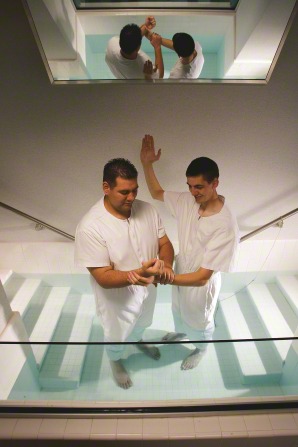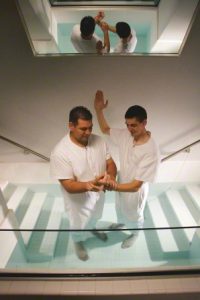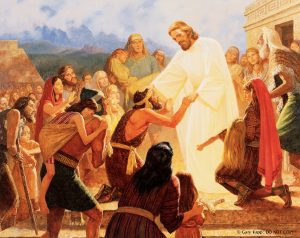As the gateway through which all must pass to enter the kingdom of God, baptism is easily one of the most important and sacred rituals in the Church. The symbolism is powerful; Paul explained that being immersed in the water and then rising from it represents death and resurrection, respectively, and the water itself denotes the washing away of sins in order to begin a new life as a disciple of Christ. It binds us to God in the Abrahamic covenant, which places us in the latter’s family and stipulates that if we do everything that we can to follow God’s commandments, we can receive salvation in return.
The Source of the Power
Obviously, the power of baptism is not really in the water, nor in the white clothing, nor even in the space in which it is conducted. The ritual itself has meaning, and when done properly, its enactor has permission from God to help someone pass through it; from that, baptism derives its power. So important is the proper authority to perform this ritual that Jesus Himself walked about many miles out of His way to meet John the Baptist for it.
Consider, too, the fact that according to the Book of Mormon, Jesus Christ appeared to people in the Americas after His ascension. One of the first things that He did was to teach them the proper way to perform baptisms. Having been spared natural disasters because of their faith and repentance, they were ready for that step, and they rejoiced in it.
To begin, Christ called Nephi forth from the gathered crowd and specifically gave him the power to baptize. He then did the same for an unspecified number of others. He taught them the exact motions to use and the perfect words to say, after which he commanded them not to fight about it, for there was only one way. Disputations over doctrine and rituals were largely the reason why the priesthood was lost after the Ascension, so it makes sense that the Lord would try to warn His people against it, despite knowing the inevitability of the Great Apostasy.
Clearly, then, the true Aaronic priesthood, held by a worthy individual who was granted it by God, is nothing less than essential.
A God of Order
On my mission, one of my companions and I were teaching an investigator about the concept of baptism, hoping to convince her to set a date to make those covenants herself. She felt that her baptism as a child was valid because her priest was a good man who was well-versed in the Bible. Having recently reviewed the Plan of Salvation with her—everything from our premortal life to entering one of three kingdoms—I asked her if she felt that it was the truth. She answered in the affirmative. Then I reminded her that the church in which she grew up did not share such convictions, and I asked her why God would give His authority to someone who would not use it to support His precise plan.
My companion then chimed in with the aforementioned story about Christ’s appearance to the American people, reading aloud the baptism ritual as described in 3rd Nephi 11. After that, she asked our investigator whether her baptism had been anything like that. She admitted that it had not. We urged her to consider the fact that if the Book of Mormon is true, then there is a certain manner that the Lord wants baptisms to be conducted, and to follow Him, she must be willing to make sacred covenants the way that He instructed.
Shortly after this lesson, my companion and I were transferred to a new area. Unfortunately, we lost touch with that investigator and never found out whether she accepted the invitation to be baptized. Still, the Spirit testified potently of the truth of our words. To avoid confusion and maintain order, the Lord instituted the Aaronic priesthood and charged its worthy holders with the task of performing baptisms, the outward demonstration of an inner promise. There is only one way to do it, and someone with permission to act in His name—permission which is granted not just because of the content of the individual’s heart, but because of his commitment to use it to promote God’s true plan—must perform it.
Hence, the restoration of this priesthood is truly one of the greatest blessings of our dispensation.
About Ashley Morales
Frequently whimsical and overly optimistic about how much time it will take to do things, Ashley Morales is deeply passionate about the gospel and all kinds of creativity. Her hobbies include philosophically analyzing nearly every book, play, video game, and movie that she consumes, writing music and short stories, promising herself that she will finish writing her novels, going to sleep too late, eating foods she's never tried, putting off cleaning her house, browsing Zillow, spending as much quality time as possible with her wonderful husband, trying to be a good mother to her fantastic children, and never finding the balance between saying too much and too little. One day, she hopes to leave a positive mark on the world and visit every continent (except Antarctica) with her family.
Twitter •




 Watch a video about the restoration of the gospel on lds.org
Watch a video about the restoration of the gospel on lds.org